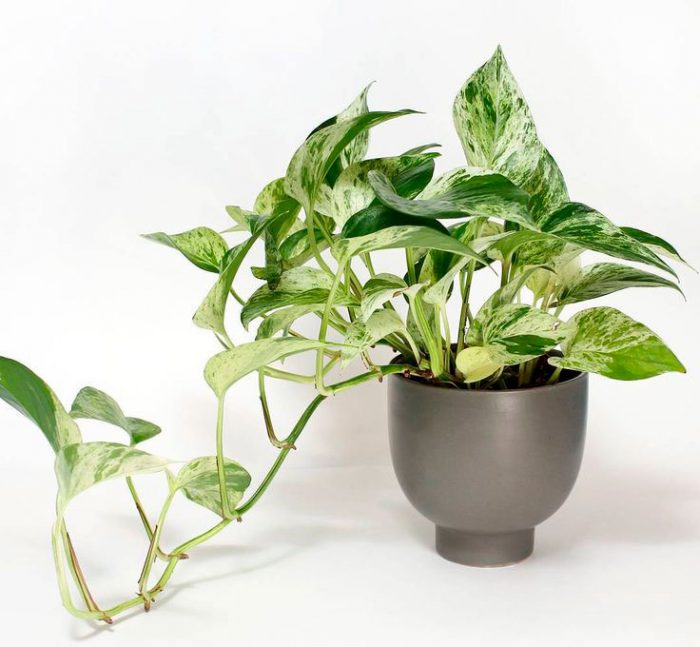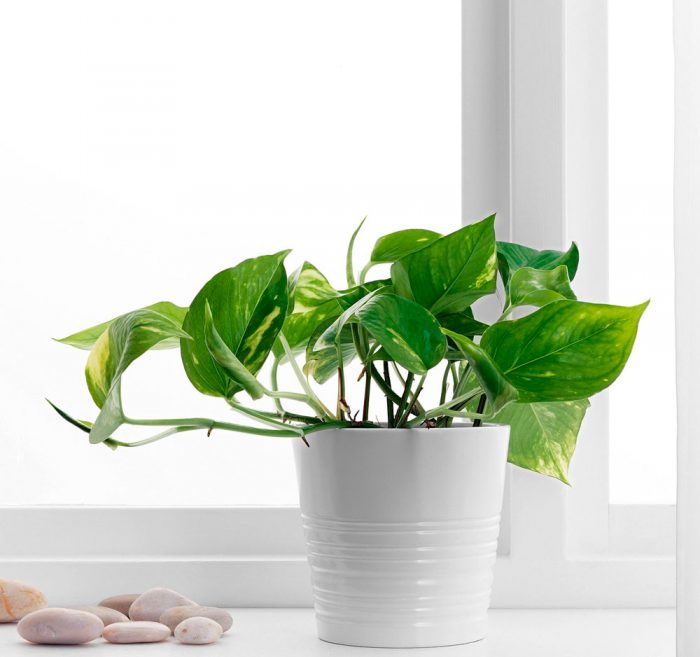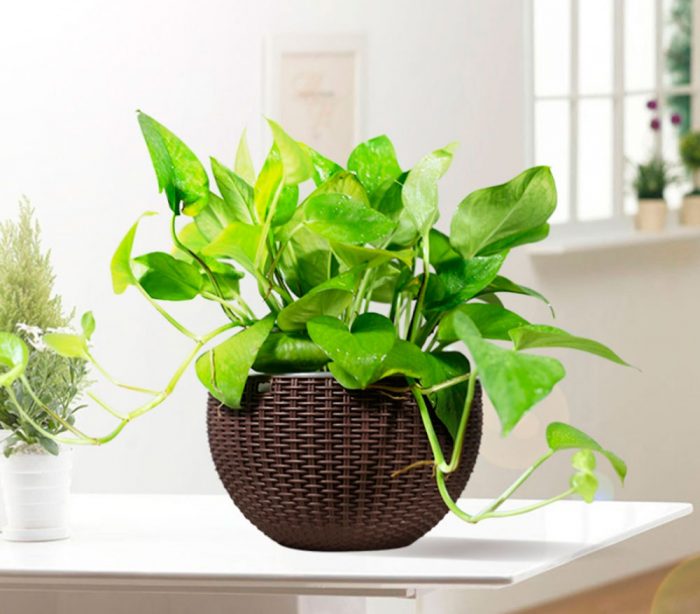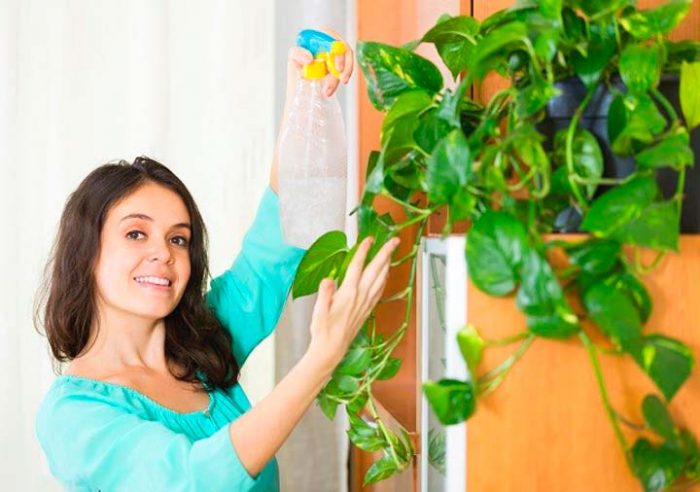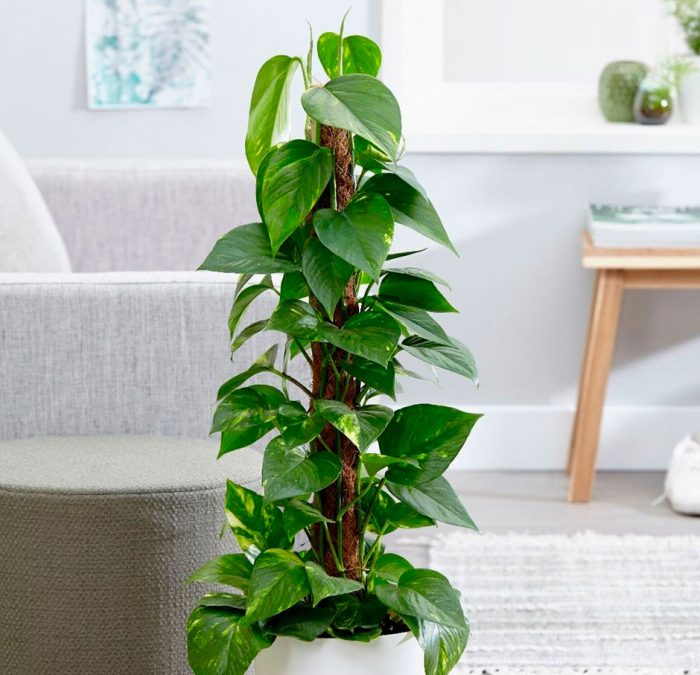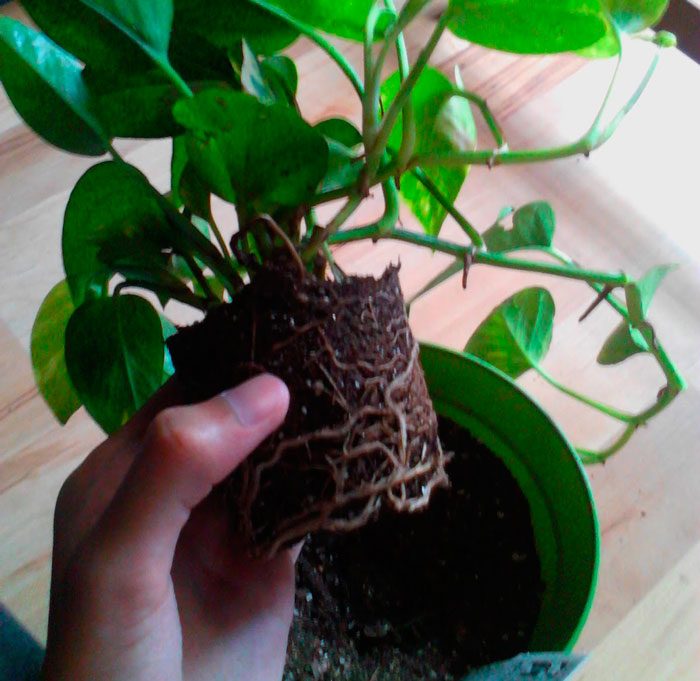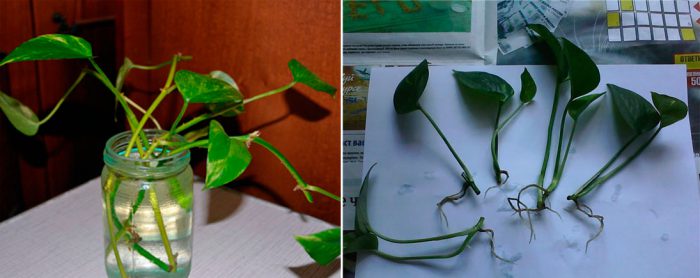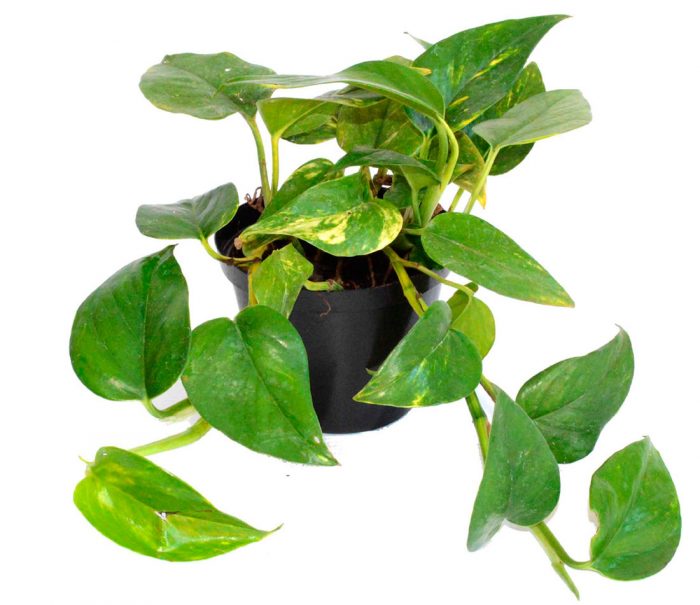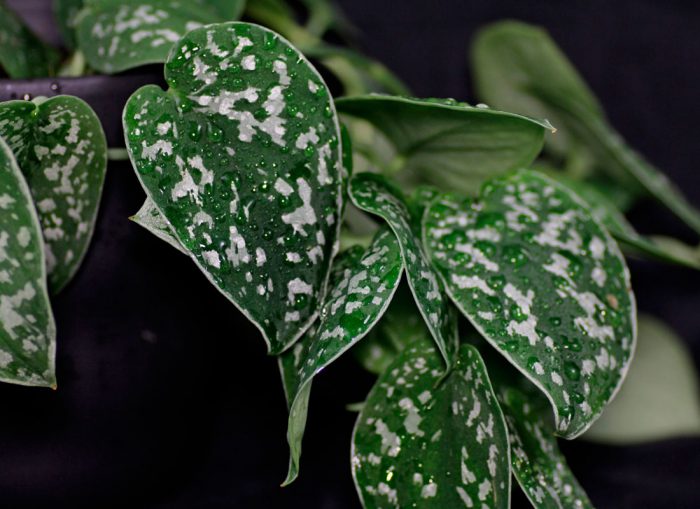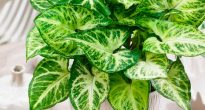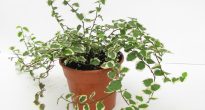The plant Scindapsus is part of the Aroid family. This genus unites about 25 species, which are represented by vines. Under natural conditions, they grow in the tropical forests of southeastern Asia. The name of the genus was derived from the Greek word "skindapsos", which translates as "ivy-like tree." Quite often, inexperienced growers confuse Scindapsus liana with Epipremnum (Epipremnum) because these plants belong to the same Aroid family and have striking similarities. Below we will focus on the epipremnum, but to make it more convenient, both of these plants will be called scindapsus.
Content
Brief description of cultivation
- Bloom... Scindapsus is grown as an ornamental deciduous plant.
- Illumination... Penumbra or shadow (the flower should stand at a distance of two meters from the south-facing window). Variegated varieties need more light than those with green foliage.
- Temperature regime... During the growing season - from 20 to 22 degrees, and in winter - from 14 to 16 degrees.
- Watering... Water must be systematically and moderately. Do this immediately after the soil mixture in the pot dries out to 1/3 of the depth.
- Air humidity... It should be only slightly higher than usual (about 25 percent). Liana needs to be systematically moistened from a sprayer, regularly arrange a warm shower and rinse the foliage with a damp soft cloth (sponge).
- Fertilizer... The plant is fed throughout the growing season with a frequency of 1 time in 15–20 days, for this, a complex mineral fertilizer is used, while only ½ part of the dosage recommended on the package by the manufacturer is taken. In winter, feeding should be more rare - once every 6 weeks.
- Dormant period... From about the second half of November to the last days of February.
- Transfer... While the liana is young, she needs an annual transplant. Adult plants are transplanted once every 2 or 3 years.
- Pinching, garter, trimming... They are carried out systematically.
- Reproduction... By layering, dividing the stems and grafting.
- Harmful insects... Aphids, thrips, spider mites, mealybugs and scale insects.
- Diseases... Rot may appear on the bush, and also due to improper care or due to unsuitable conditions of detention, it loses its decorative effect.
Features of scindapsus
In nature, the scindapsus plant is a powerful semi-epiphyte liana that wraps around tree trunks, while along them it can rise to a height of about 15 m. The scindapsus, like its related monstera plant, has not only a fibrous underground root system, but also aerial roots , which help the liana to climb very high and crawl thousands of meters. In Sri Lanka and Florida, such a liana occupies very large territories, and therefore they are fighting with it there as a dangerous parasite that negatively affects the environment in the region.
Under indoor conditions, scindapsus is a climbing plant with decorative variegated or rich green foliage, which is similar to the leaves of some species of philodendron. Its leaf plates are alternately simple, glossy and leathery, their shape is oval. During flowering, a small inflorescence is formed that looks like an ear of corn, which is wrapped in a stipule like a blanket. However, the liana grown at home blooms extremely rarely, but it is undemanding to care for.
Scindapsus care at home
Temperature regime
Best of all, in the warm season, scindapsus grows and develops at an air temperature of 20 to 25 degrees. In winter, it is necessary to ensure that the room where he is located is not colder than 12 degrees.
Illumination
This vine is one of the shade-loving plants, therefore it can be placed at a distance of about 200 cm from a brightly lit window. But it must be borne in mind that variegated varieties need brighter lighting than green-leaved forms, otherwise the variegated pattern on their foliage may fade or disappear altogether. If the flower is placed in the darkest corner, then this can lead to massive flying around the foliage.
Watering
Watering the plant is relatively rare and not very large amount of water. So it is necessary to moisten the substrate in the pot only after it dries out by 1/3 in depth. If you start to water it more often or use more water for this, then rot may appear on the roots.
Air humidity
Liana grows best in a slightly high humidity (about 25 percent). However, it can develop quite normally at a lower level of air humidity, but if you systematically moisten such a flower from a sprayer or wipe the foliage with a damp soft cloth, it will become even more beautiful. In the warm season, he can sometimes be given a warm shower, and in the winter months you need to make sure that he is as far away from heating appliances as possible.
Pruning
For 1 year, the stems increase in length by about 0.4 meters. In this regard, in order for the scindapsus to look neat all the time, it is necessary to systematically carry out formative pruning. If necessary, the trimmed parts of the shoots can be used as cuttings. And if desired, the bush can be regularly pinched, which will make it more branched. However, most often, supports (stairs or arches) are used to form young vines. For the formation of adult bushes, a plastic pipe is used, in which several holes are made. It is filled with moistened sphagnum and wrapped with copra. The air roots of the plant are directed into the holes made, this will allow them to receive additional moisture and nutrients.
Top dressing
In the spring-autumn period, the liana is fed regularly once every 15–20 days, and in winter the frequency of feeding is reduced to one every 1–2 months. For this, a liquid complex fertilizer is used in a half dose.
Scindapsus transplant
Young specimens need a systematic transplant, which is carried out every year. When the plant becomes an adult, it will be possible to replant it less often, or rather, once every 2 or 3 years. It is recommended to transplant at the beginning of the growing season, and this time falls in February – March.
It is recommended to use a low, but wide container for planting a flower, in this case it will be possible to systematically plant cuttings in it, which are rooted in advance, thanks to which the bush will become even more lush and effective. The most suitable substrate for transplanting should include sand, peat, leaf and humus soil (1: 1: 1: 1), while it is recommended to add a small amount of expanded clay or perlite to it. Don't forget to make a good drainage layer at the bottom of the pot.
Reproduction of scindapsus
Most often, flower growers propagate scindapsus by cuttings. The apical cuttings cut off during the formation of the bush for rooting can be placed in a container with water or planted in a substrate, they will give roots rather quickly. The main conditions for successful rooting:
- on each handle there should be 2 or 3 leaf plates;
- the air temperature must be at least 22 degrees;
- a fairly large amount of light is needed.
During the harvesting of cuttings, a cut is made under the knot, after which the cut sites are treated with a solution of a means that stimulates root growth. Then they are planted for rooting in a soil mixture consisting of sphagnum and sand. Top cuttings are covered with a plastic transparent bag or glass jar. Roots appear after 15–20 days. You can also propagate a liana by layering and dividing the stem.


Watch this video on YouTube
Diseases and pests
Scindapsus is characterized by a rather high resistance to both diseases and harmful insects. But with improper care and inappropriate conditions for growth, problems can arise with it.
Possible problems
- Yellow foliage... Most often this happens due to the fact that the plant suffers from a lack of nutrients. In this case, it must be fed.
- The tips of the sheet plates dry out... This happens extremely rarely and only if the flower is not far from a working heater and it has not been moistened with a sprayer for a very long time.
- Foliage flies... This is due to poor lighting and lack of power. And a draft can also cause the leaves to fall.
- Rot has appeared on the shoots. Stems rot when the plant is in a cool place and is watered too often and abundantly.
- Foliage loses its decorative effect... If in variegated forms the foliage becomes simply green and its shrinking is observed, this means that the plant does not have enough light. If, in green-leaved plants, the leaf plates become faded and specks form on them, then this indicates that the lighting is too intense.
- If the flower hits a fungal or viral disease, then it will be very difficult to cure it. However, such a plant is able to quickly recover. And it is also easily propagated by cuttings, in this regard, in case of emergency, prepare cuttings from healthy shoots and just grow a new flower.
- Pests... Most often, aphids, spider mites, thrips and scale insects settle on the flower. To get rid of pests, the bush will need to be treated with Actellik's solution (20 drops per 1 liter of water). If necessary, you can carry out up to 4 treatments with a break of 7 days.
Can Scindapsus be grown at home?
Some growers are afraid to decorate their home with scindapsus, because it is popularly considered a "muzhegon". So, they call those plants that are expelled from the husband's apartment. Believe it or not, it's up to you, but there are many happy families who have a husband at home and a scindapsus on the wall.If you are still afraid to start such a plant, then choose any other flower, because there are so many of them. It is interesting that the eastern sages noticed completely different qualities in such a vine: it is able to absorb laziness and stagnant energy, soften the tense atmosphere in the apartment, inspire creativity, and also help find a way out of the psychological impasse.
Types of scindapsus with a photo
Scindapsus golden (Scindapsus aureus)
This type is most popular with florists. It is grown as an ampelous or climbing plant. If you decide to put it on the wall, then in this case the flower stems can grow in length up to 200 centimeters or more. The foliage of this species is outwardly similar to the philodendron, but it has a more spectacular color. On the surface of the leathery, shiny green foliage, there are splashes and smears of yellow color. The following cultural forms of golden scindapsus are considered quite decorative:
- «Marble Queen»- sheet plates are almost completely white;
- «Golden Queen»- in this form, the foliage is rather yellow, and there are green spots on it;
- «Tricolor»- on the surface of the spectacular foliage there are many streaks of greenish, pale cream and dark green.
Scindapsus painted (Scindapsus pictus)
The stem of such a plant is angular; over time, warts form on its surface. The leathery short-peaked foliage of an egg-shaped dark green color is about 7 centimeters wide and up to 15 centimeters long. Its surface is decorated with silvery stains. The best varieties and shapes:
- The variegated form of Scindapsus pictus var. argyraeus... The foliage of this form is shorter and wider than that of the main species. On its surface, there are small specks of regular shape.
- «Exotic". On the surface of large leaves, there are silvery long strokes and large spots.
Florists also grow such types of scindapsus as: feathery, forest and Siamese.
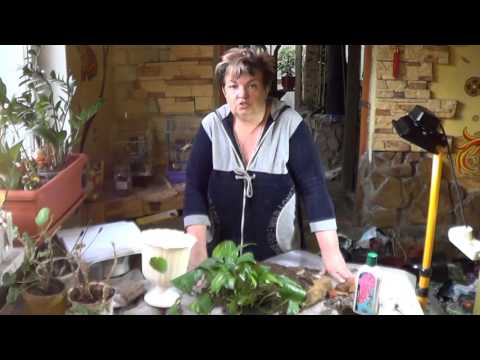

Watch this video on YouTube

